|
I
lived in Kidbrooke and Blackheath for 29 years, passing the Queen's
House and the Cutty Sark every day on the way to school in
Greenwich. Kings and queens of England enjoyed this park, I visited
it regularly whilst I lived there, and I hope you will do the same
through these pages.
I am
absolutely delighted that the shorthand dictionary gives the correct
pronunciation of Greenwich, i.e. "grinnidge".
Word counts:
Dates as 2 words - 1945 = nineteen forty-five
Monarchs as 3 words - Henry VIII = Henry The Eighth
Some hyphenated words counted as 2 = boat-shaped
Paragraph numbers not included
Introduction, Blackheath, General Wolfe, South Building, Planetarium,
Altazimuth Building, Onion Dome

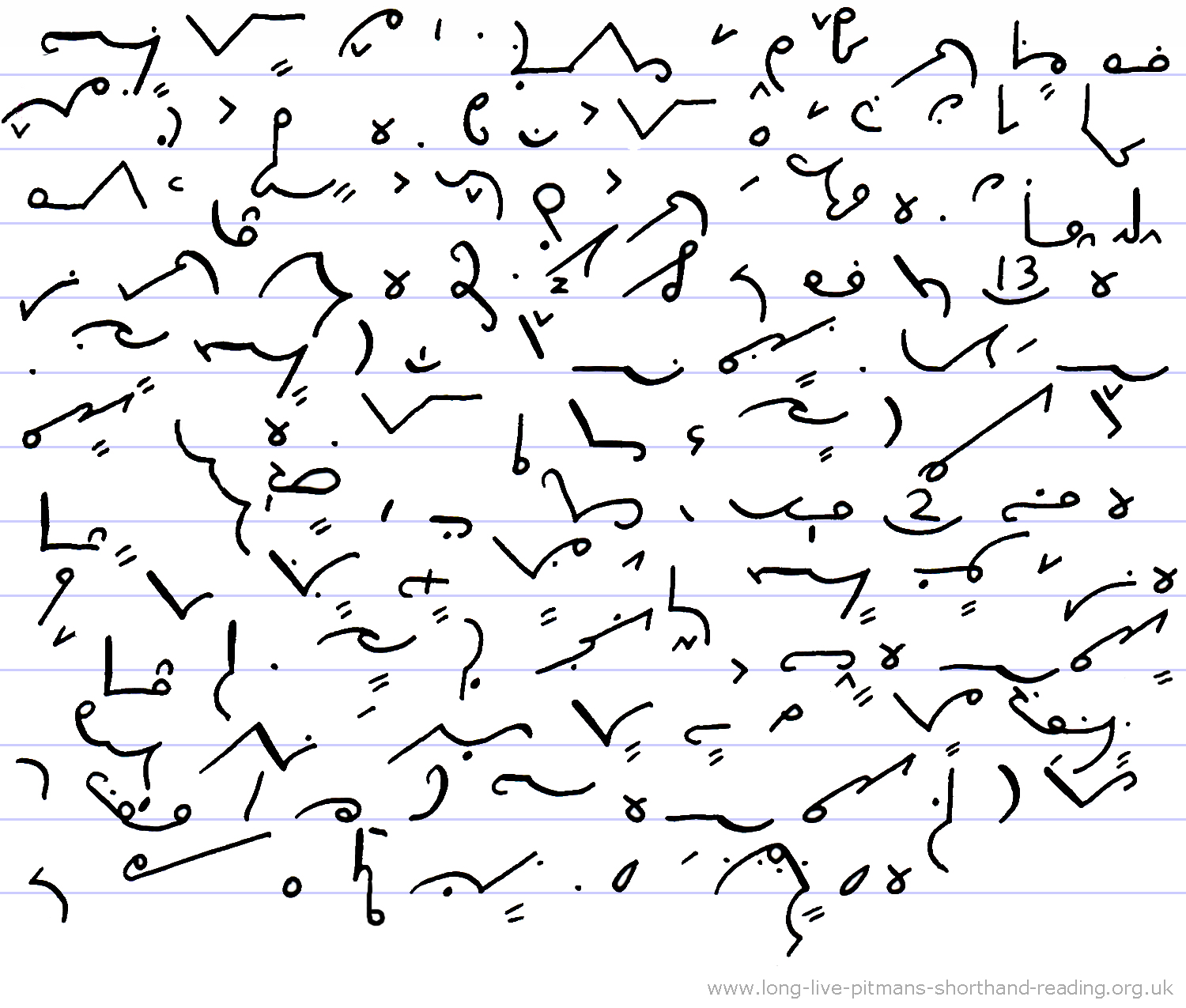
1. Greenwich Park lies on an escarpment on the south side of the
River Thames, six miles east of the City of London*.
The southern end of the park is on the flat land at the top of the
scarp with views of the entire sweep of the river and northwards.
The land continues down the hill to river level. There has been a
royal residence here since before 1300. The Manor of Greenwich was
owned by King Henry IV and King Henry V. The park itself began when
the Manor was inherited by the Duke of Gloucester, who gained
permission to enclose 200 acres. He built Bella Court Palace and the
tower of Greenwich Castle on the hill. On the Duke's death, the
Manor estate reverted to the Crown. King Henry VII rebuilt
and renamed Bella Court as the Palace of Placentia or Pleasaunce,
which means pleasure garden. King Henry VIII was born here, as were
his daughters*
Mary I and Elizabeth I.
* Omission phrase "City (of) London"
*
"daughters" Always insert the vowel in this and "auditors"
"debtors"
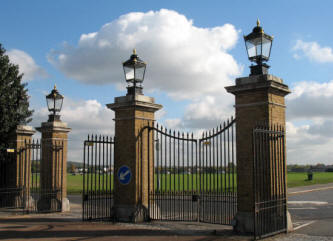
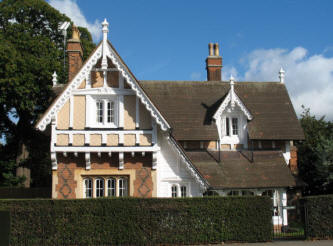

2. Blackheath Gate is on the south side of the park, facing the expanse
of the heath. This is best known nowadays as the starting point of the
London Marathon which
takes place*
every April. The runners form their huge queue in the long avenue in the
park and the marathon route turns left outside the gate and makes for
Charlton and Woolwich. There the route doubles back on itself, passing
the park again on the lower road through the town of Greenwich, making a
detour over to the Isle of Dogs and finishing in The Mall by St James's
Park.
The route thus goes from a former royal residence to the present one at
Buckingham*
Palace.
* "Buckingham" The H is not pronounced
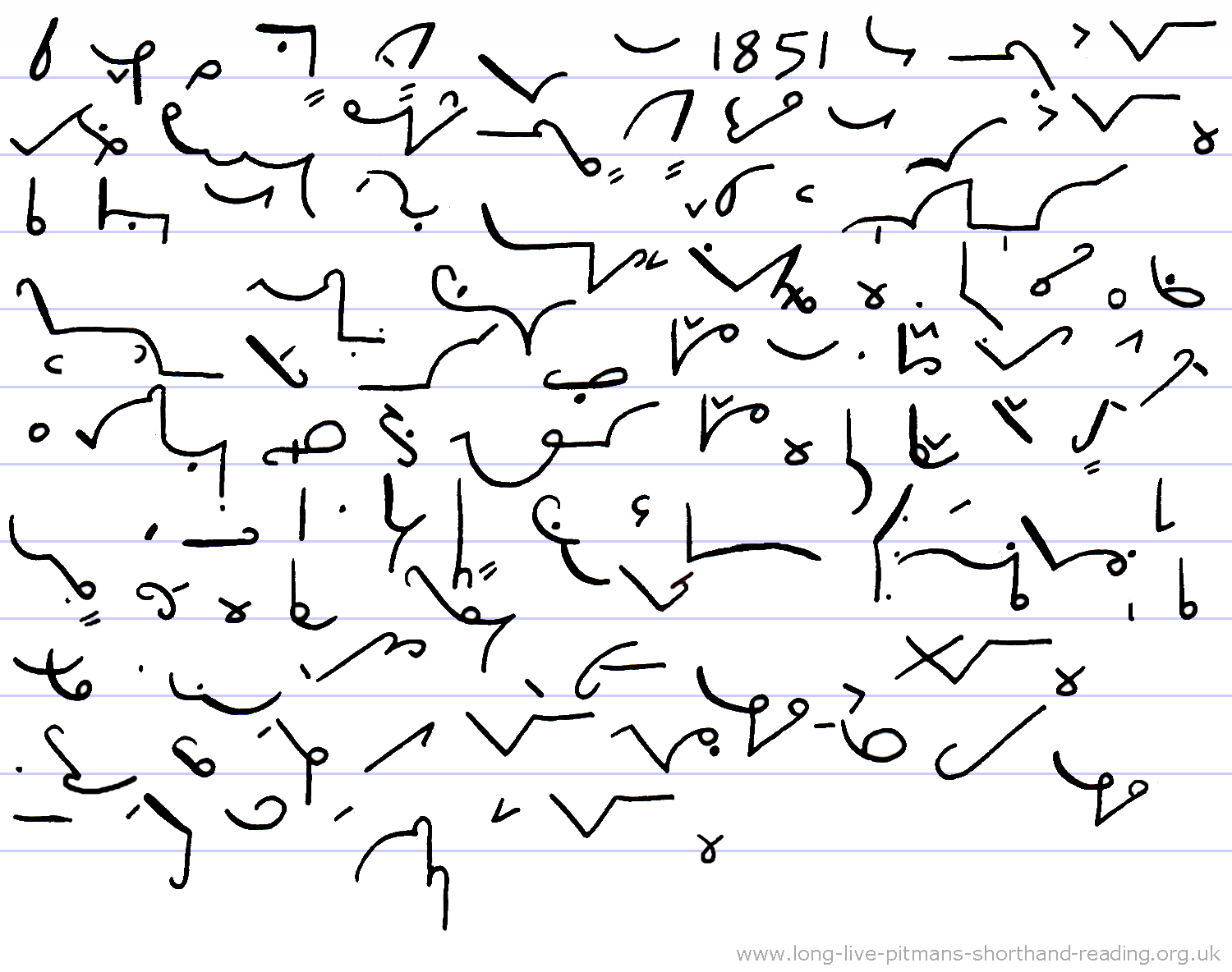
3.
Just
inside is the Gate Lodge built in 1851 for the keeper of the park, to
replace the 17th century Keeper's Lodge that was in the middle of the
park. It is decorated in the ornate Victorian style, with multi-coloured
brickwork and intricate floral bargeboards*.
The top half is faced with buff-coloured glazed tiles in a diamond
pattern and the roof has alternating courses of plain and fish-scale
tiles. It was designed by John Phipps who gave it an additional Tudor
flavour with the timber jetty and beams at the front. It is not
presently part of the amenities but it is nevertheless a fitting
ornament to welcome visitors to the royal park.
The plainer buildings opposite are the park and police offices, where
visitors can obtain information and literature on the park.
* "board" Full strokes B + Rd when written on its own
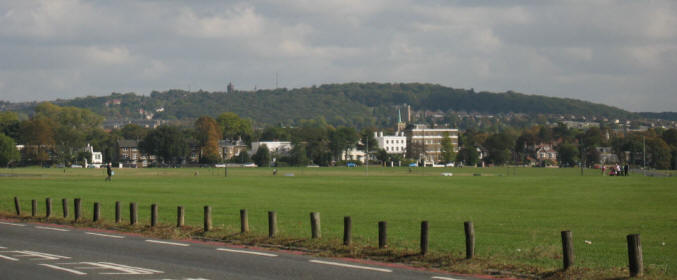
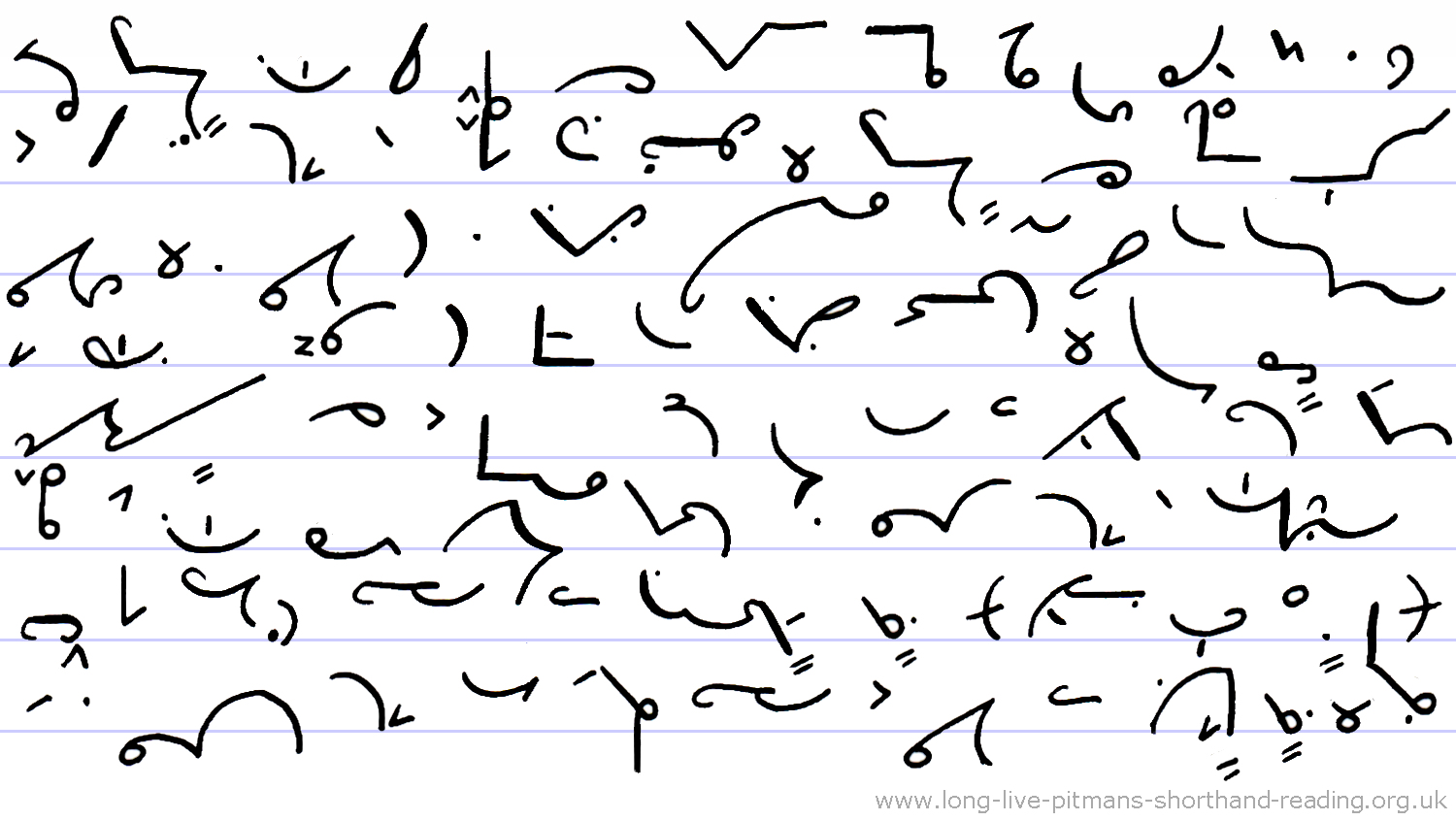
4. Here is Blackheath Common just outside the main park
gates and this view shows about a third of the large area of flat
grassland.
Blackheath means "dark coloured heathland".
The heath was a barren wilderness and not used for farming, but the
stony*
soil was dug for ballast and gravel. After the Second World War, most of
the diggings were filled in with rubble from bomb-sites and the common
is now level, apart from a small area of undulating ground at the
north-east corner, called Vanbrugh Pits (locally known as The Dips), and
a similar area in the opposite corner of the heath called Eliot*
Pits.
* "stony" Insert the final vowel, as "stone" could also make sense
* "Eliot" Names tend to have full strokes for greater clarity
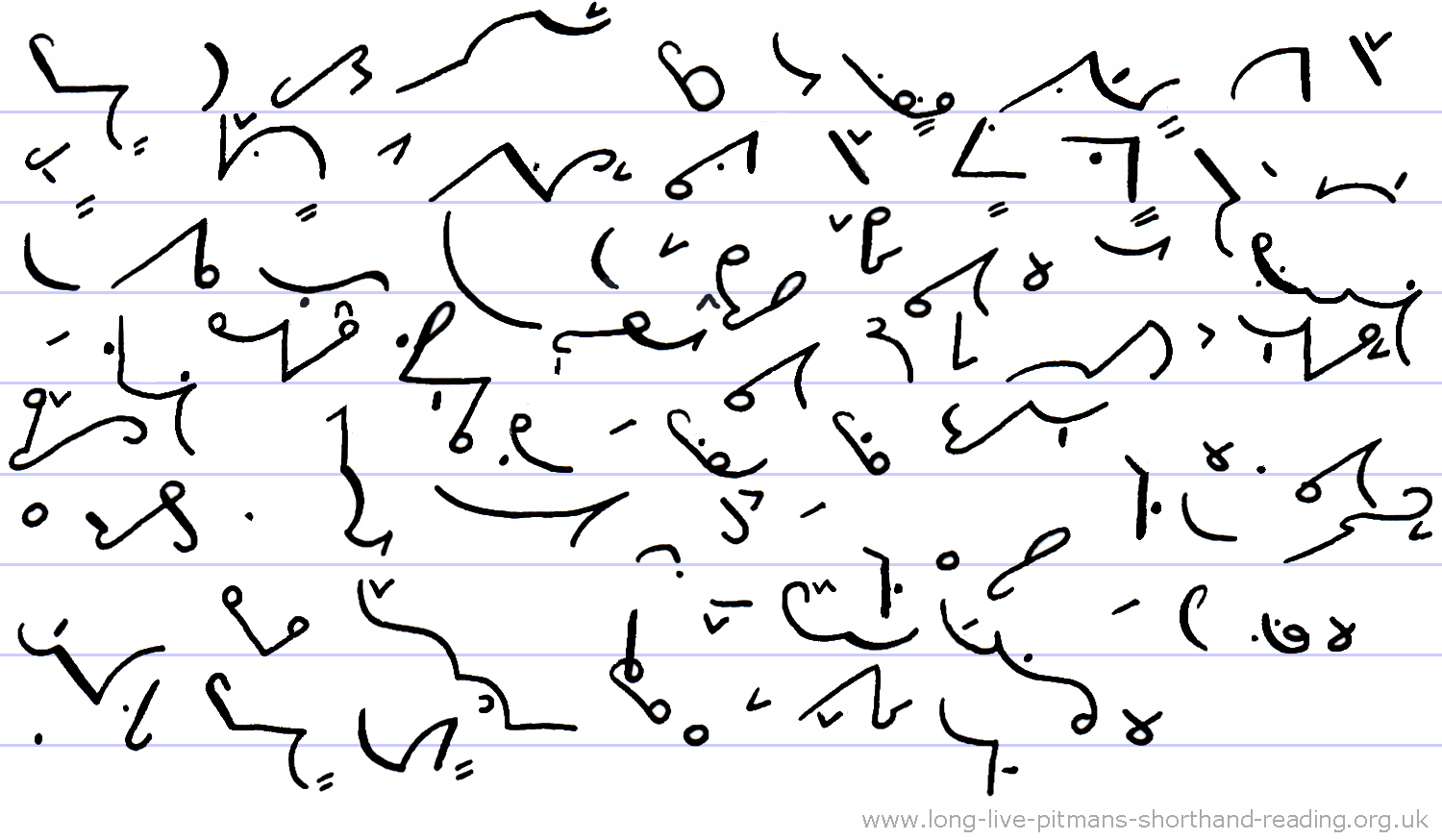
5. Blackheath was one of the rallying places for the Peasants'
Revolt led by Wat Tyler and the rebellion headed by Jack Cade, both
of whom have
roads
named after them on the south-west side of the heath.
In
the 17th
and 18th
centuries, stagecoaches crossing the heath were at the mercy of the
notorious highwaymen and it was not the safe and pleasant*
place that we know today.
The heath has always been a natural meeting point and today is used
for recreation, football, sports, firework displays, kite flying,
funfairs and other events. The edge of Blackheath Village is on the
right of the photo.
* "pleasant" Insert the vowel in this and "pleasing"
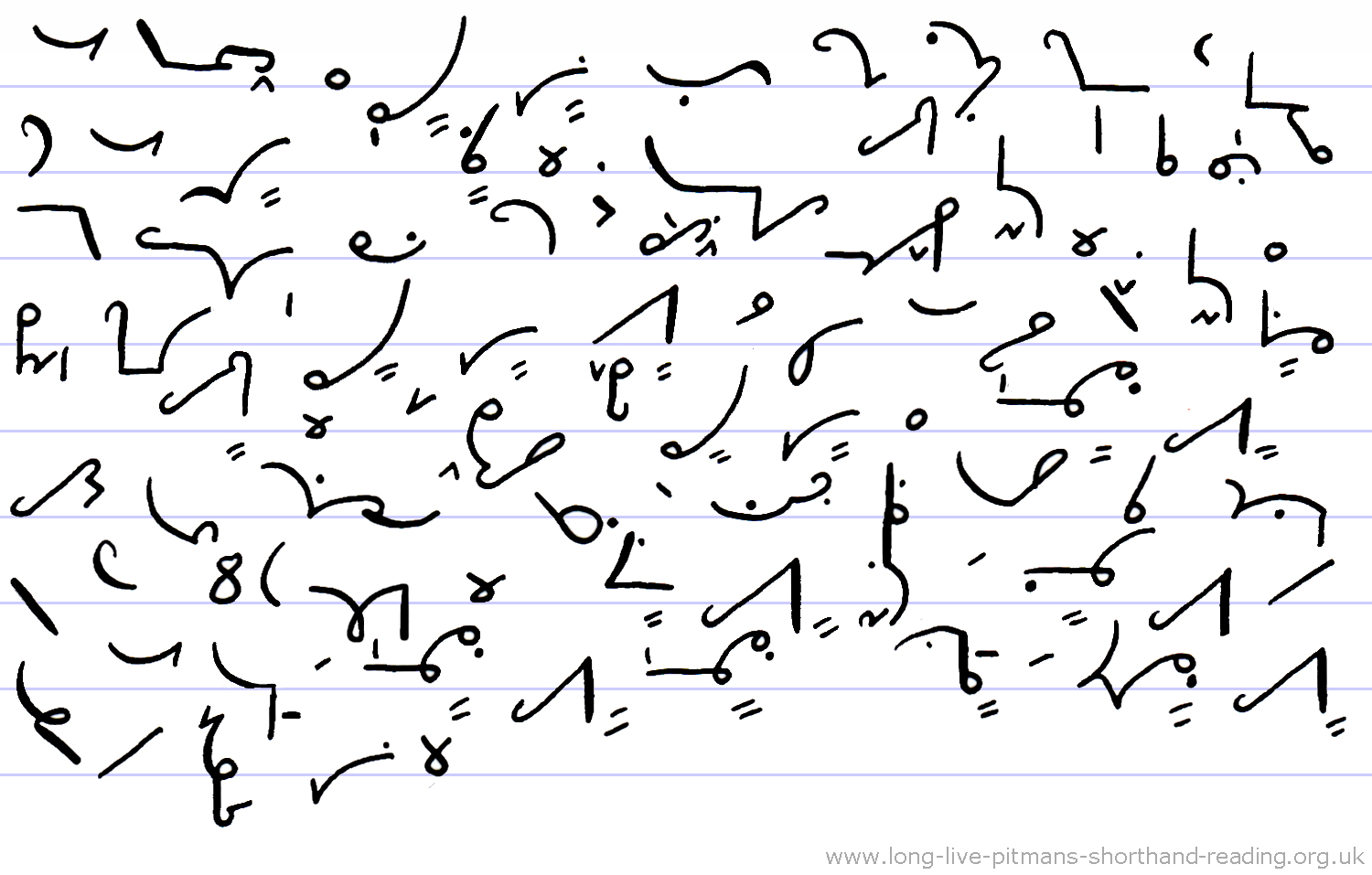
6. In the
background is Shooters Hill, named from the archery practice that
took place there in the Middle Ages. The Victorian water tower at
its summit can be clearly seen from all the surrounding countryside.
The tower is situated directly on Shooters Hill Road and is still in
use by Thames Water. On the south-west side of Shooters Hill is
Oxleas Wood, one of the few remaining pieces of ancient deciduous
forest, which is estimated to be over 8,000 years old. Jack Wood and
Castle Wood are visible in the photo, and Oxleas Wood, Oxleas
Meadows and Shepherdleas Wood are on the other side of the*
hill.
* "8,000" Keep the Ith well curved so it does not look like 81
* "years old" This phrase is quicker than writing the normal outline
for "old" separately
* Omission phrase "on the oth(er) side of the"
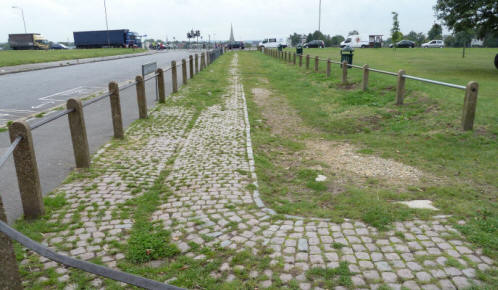
Duke Humphrey Road
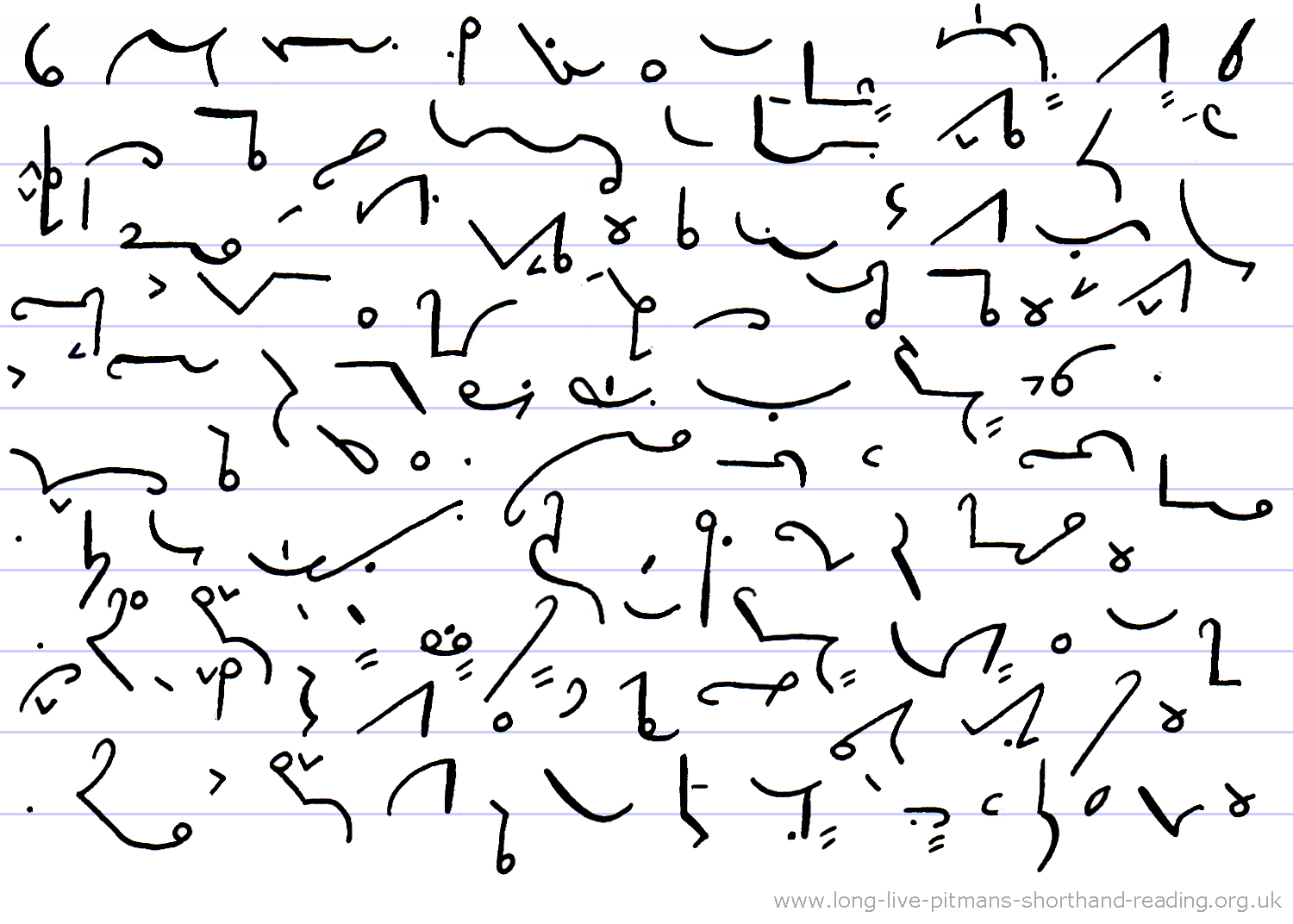
7. This
length of granite sett pavement is in Duke Humphrey Road just
outside the main gates, used for many years for donkey rides which
were offered at weekends and holiday periods. It is fitting that the
road named after the creator of the park is directly opposite the
main entrance gates. On the right of the granite path can be seen
the stony*
nature of Blackheath soil, a reminder of its past as a wilderness
covered with gravel diggings, a danger for the unwary traveller who
strayed from the established trackways. The sharp spire of All
Saints Church in Blackheath Village is in direct line of sight,
although the road is short and does not cross the heath to reach the
church. The sharpness of the spire led to its being dubbed the
Needle of Kent when it was first built.
* "stony" Insert the final vowel, as "stone" could also make sense
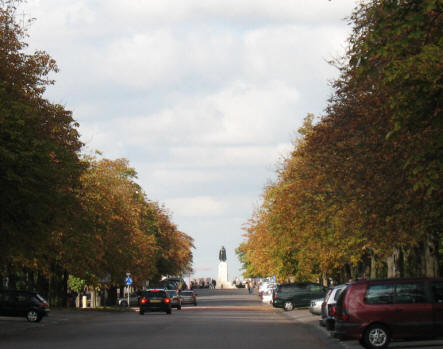
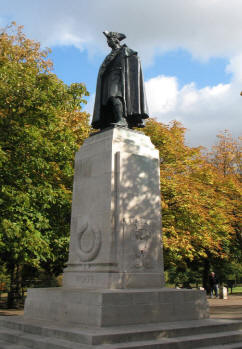

8. Blackheath Avenue leads from the gatehouse northwards
through the park to the edge of the hill, and ends with the statue of
General* Wolfe. The inscription on the back of the statue reads, "This
monument*
the gift of the Canadian people was unveiled on the fifth of June 1930
by Le Marquis de Montcalm".
Major General James Wolfe lived in Macartney House in Greenwich Park and
started his military career at the age of 13. He led the battle in 1759
that ended French control of Quebec, which paved the way for the English
to gain control of Canada from the French. He died in that battle at the
age of 32 on the Plains of Abraham, and is buried in St Alfege Church in
Greenwich. Immediately in front of the monument is the viewing area,
with seats and public telescopes overlooking the grassy slope down to
the Queen's House, the River Thames and the panoramic views of North
London.
* "General" If you felt this might be read as "John" then put a
wavy line underneath to draw attention
*
"monument" The U diphthong sign can't be placed against the final
halved N because here that stroke represents "-ment"
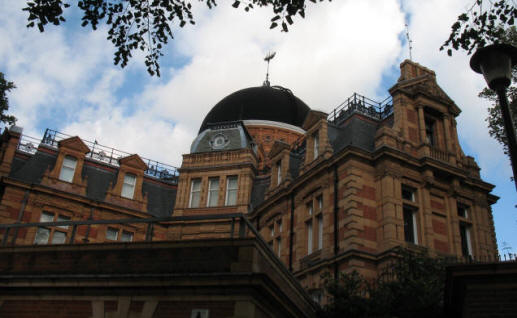
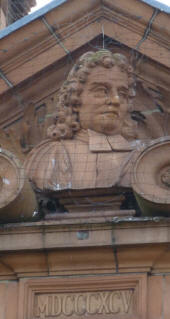



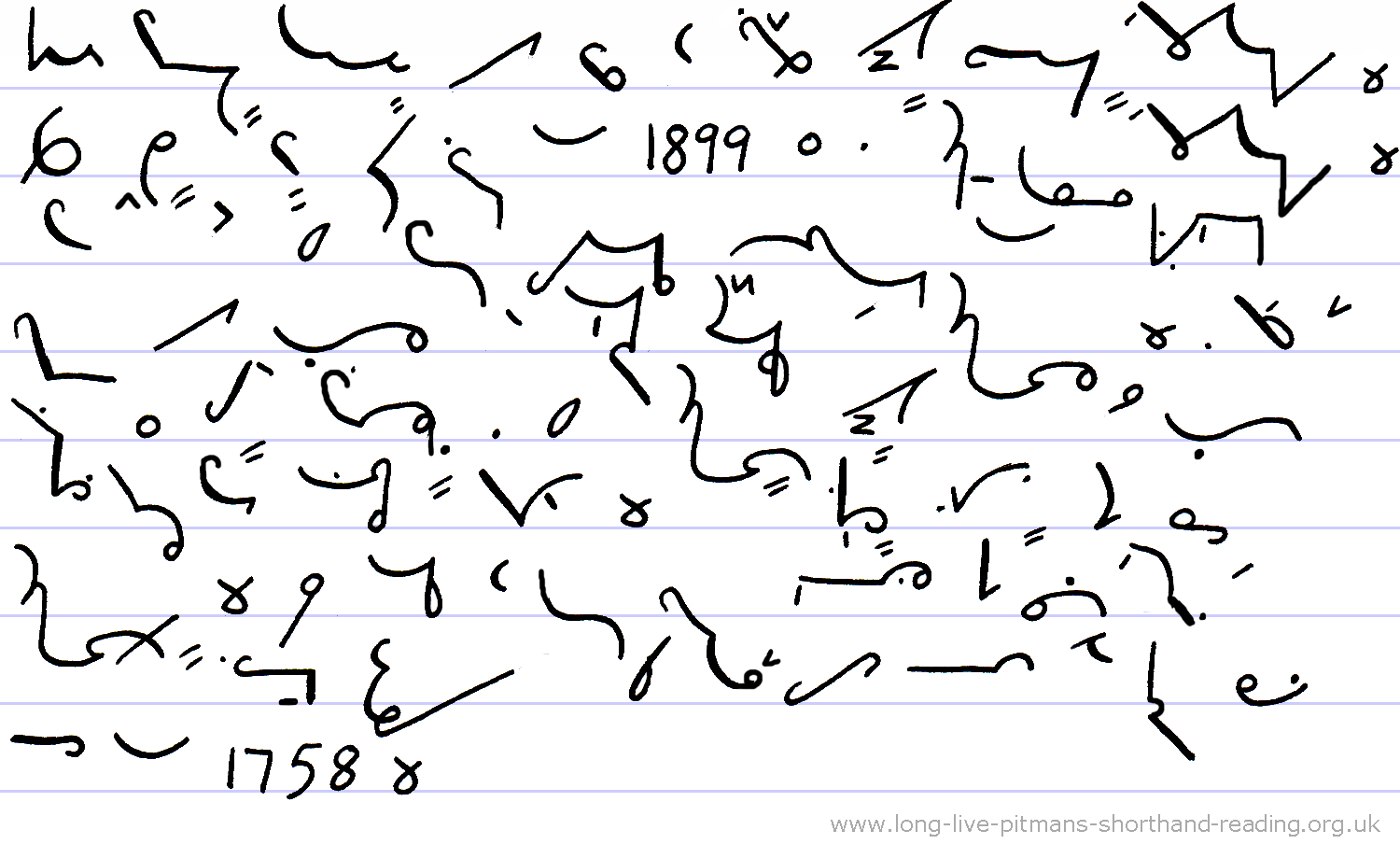
9.
At the end of Blackheath Avenue are the buildings that comprise the
Royal
Greenwich
Observatory. This is the South Building which was completed in 1899
as an astrophysics observatory. Over all the first floor windows
imprinted in terracotta brick are the names of notable*
scientists and astronomers. The bust on the pediment is John
Flamsteed, the first Astronomer Royal, and his name appears over the
entrance below. Edmond Halley was the second Astronomer Royal*.
He noticed that four previous comets had the same orbit, and
concluded that these were just one comet and that it would be seen
again in 1758.
* "notable" The N stroke is not halved, so it is not misread as
"noble"
* "Astronomer Royal" The first
occurrence in full, and then afterwards use the Ray intersection
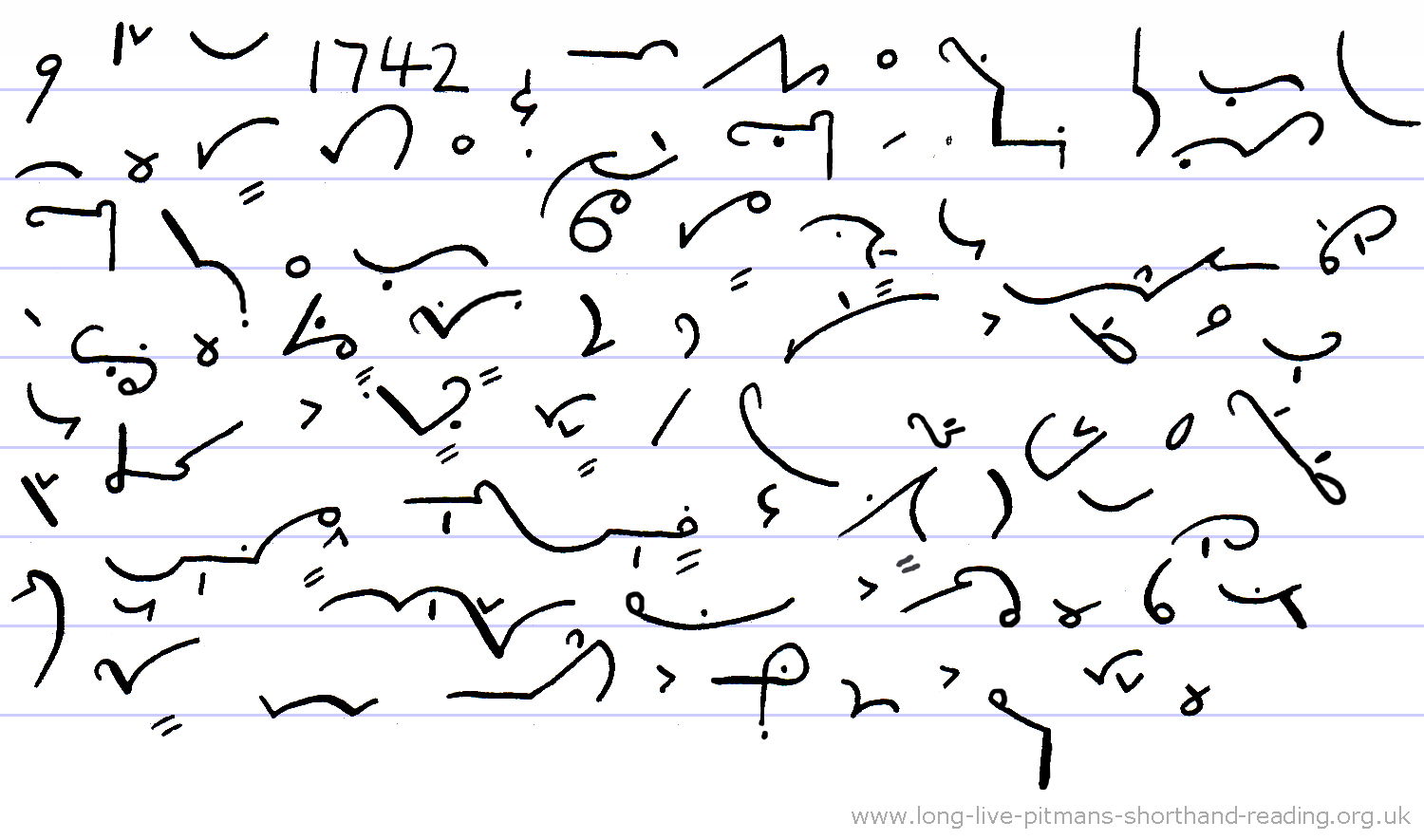
10.
He died in 1742 but when the comet returned as predicted, it was
named after him. Halley also has a lunar crater and a Martian crater
bearing his name, as well as Halley's Method for the numerical
solution of equations. James Bradley was the third holder of the
post and is known for the discovery of the "Aberration*
of Light" which further proved the
theory, first proposed by Nicolaus*
Copernicus, that the Earth was in motion and therefore not the
immobile*
centre of the universe. This enabled Bradley to improve the accuracy
of the existing estimate of the speed of light.
* "aberration" Insert the first vowel, as "operation" would also
make sense
* "Nicolaus" Using German pronunciation
* "immobile" Such negatives repeat the stroke, to avoid having to
insert the first vowel
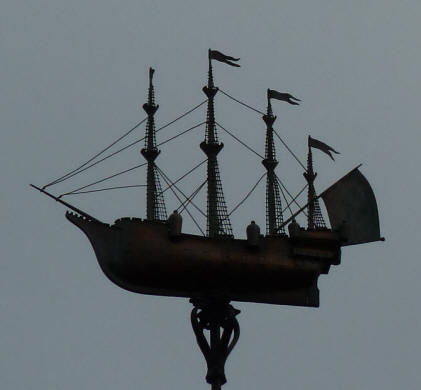
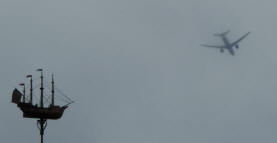
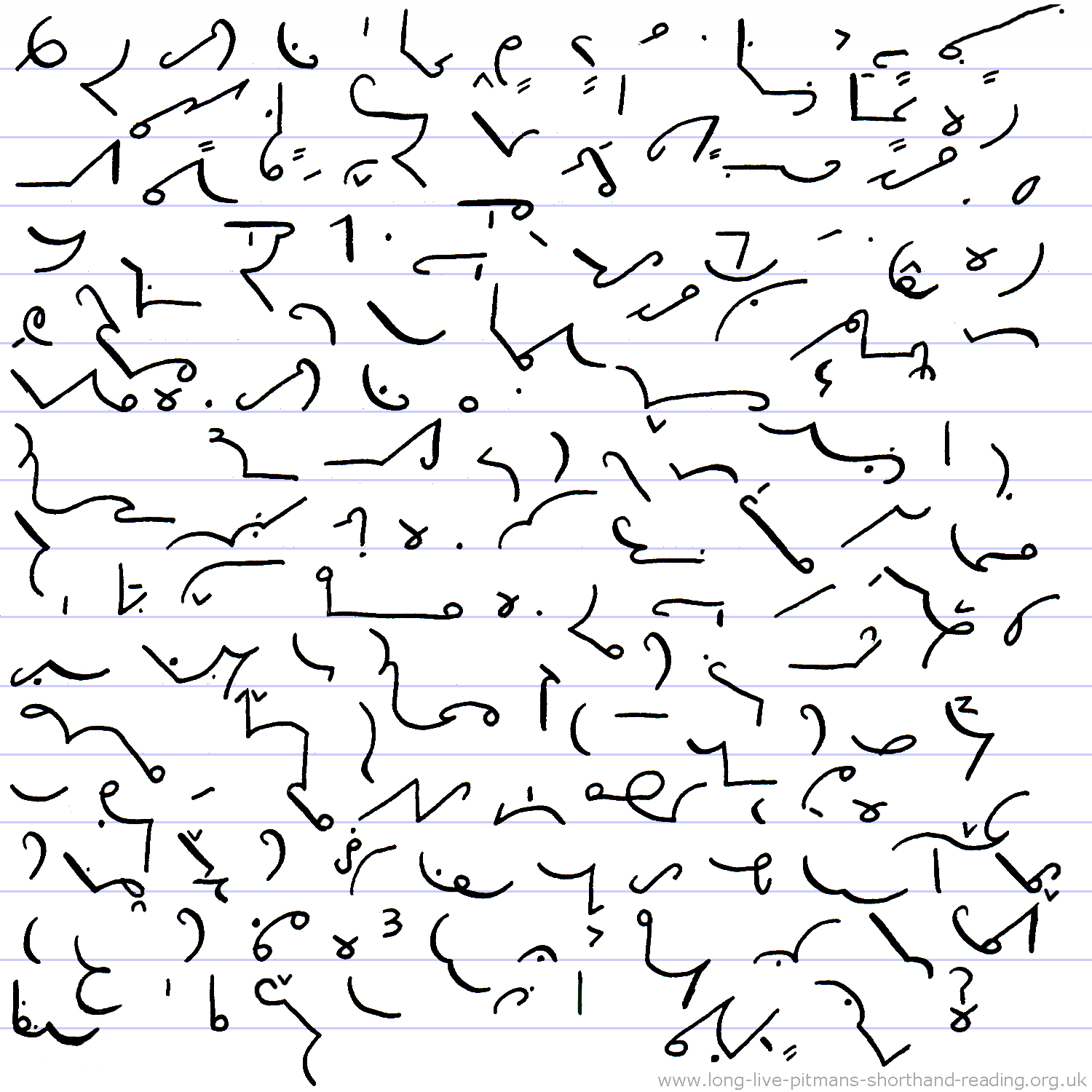
11.
This is the ship weather vane on top of the South Building and is a
depiction of the Great Harry, Henry VIII's flagship built
at
Woolwich Dockyard. She carried heavy and light guns, and bronze cannon,
and was the first English two-decker gunship, and had a crew of between
seven hundred and a thousand. She suffered problems from being top-heavy
and was later restructured to improve performance. The weather vane is a
reminder that the astronomical work carried on here was principally to
improve navigation at sea, both military and
trading.
The little vertical blobs are not figures but
turret-like structures. The ship's crew are obviously still waiting
patiently for the astronomers to deliver their completed accurate
star-maps and timetables, so that they can undertake their next voyage
in safety and return home successfully without loss. Meanwhile, they are
bemused by the fact that* they are constantly facing into the wind,
instead of having it behind them filling their sails.
What would
they have made of the strange metal bird overhead, descending on its
flight path for
landing
at Heathrow*
Airport?
* Omission phrase "by the (f)act that"
*
"Heathrow" Using separate strokes. Outlines for "hither, heather"
use the hooked stroke.
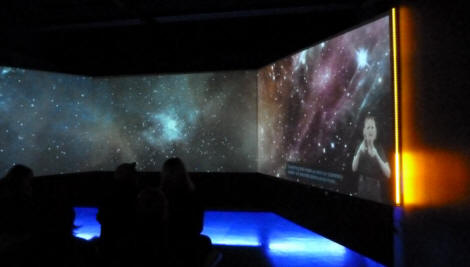

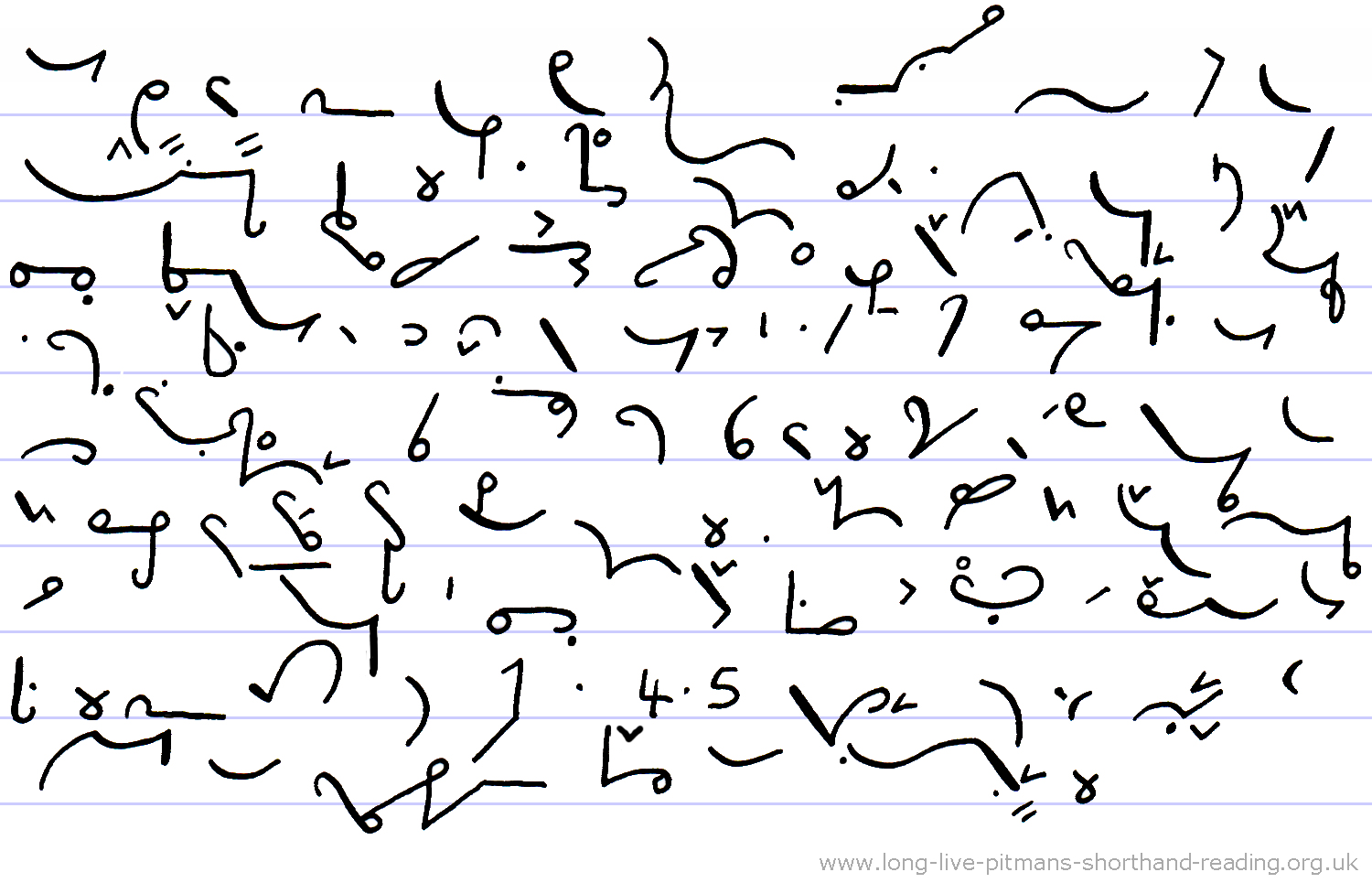
12. In the South Building you can visit
several astronomy galleries, many of which have interactive displays. A
darkened room shows a looping video on three large screens, describing
the story of the beginning*
of the universe, as understood by present-day scientists, a free taster*
of what might be enjoyed on a much larger scale in the main planetarium,
which is accessed from this building. There are two soft benches for
about 16 people, plus plenty of standing room. The item lasts about 5
minutes and is accompanied on screen by the text of the narration and
signing for the deaf. You can also see and touch a 4.5 billion year old
meteorite that landed in prehistoric times in Namibia.
* "of the beginning"
If more convenient,
this intersection can be written underneath the preceding outline or
phrase
* "taster" Insert vowel and ensure Ster loop is large, as "tester"
and "test" could also make sense
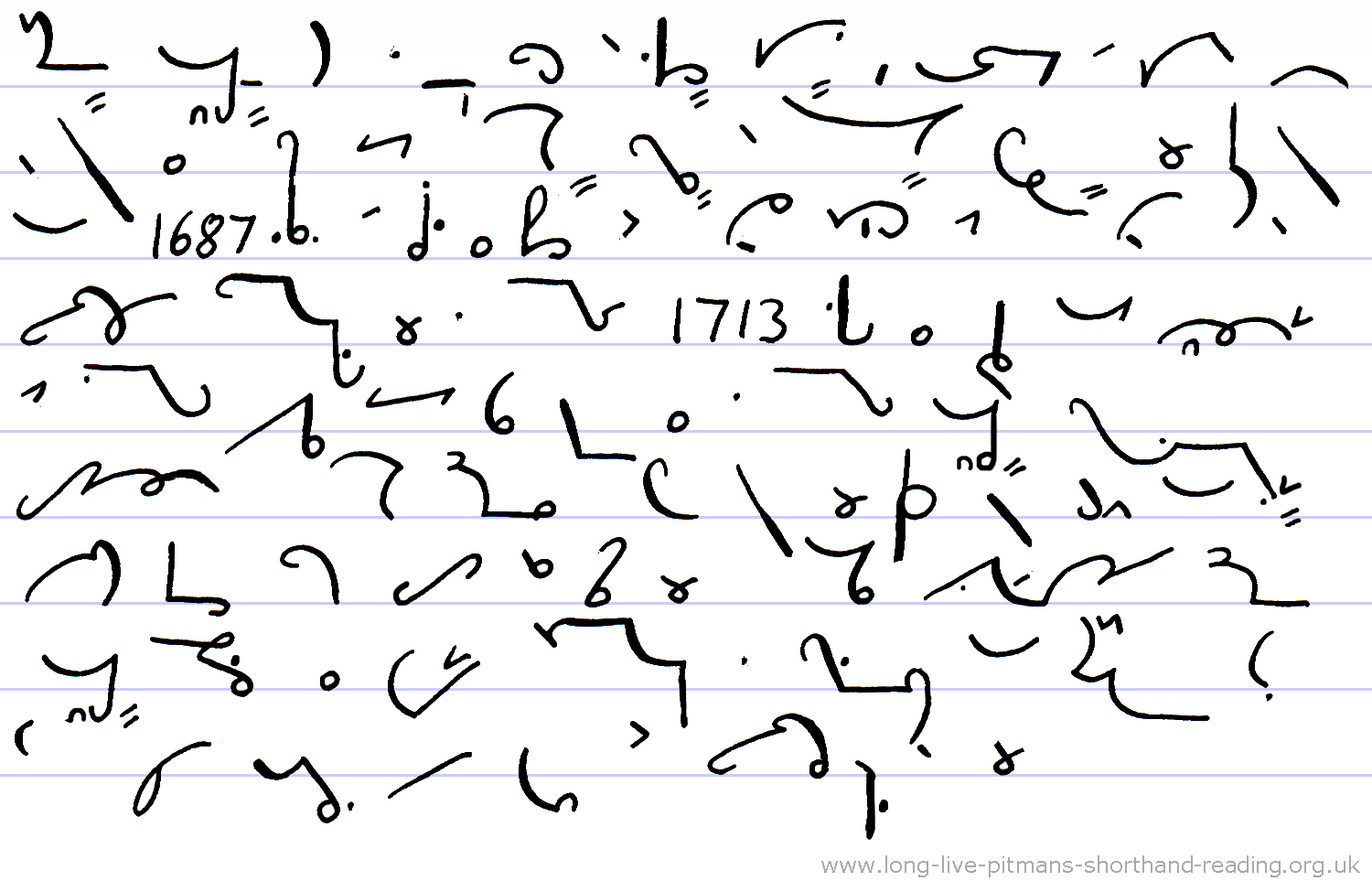
13.
Isaac Newton was a good friend of Edmond Halley who
encouraged and helped him to publish his treatise "Mathematical
Principles of Natural Philosophy".
It was published in 1687 and contains his statement of the laws of
motion and the law of universal gravitation. A copy of the 1713
edition is displayed in the museum and the caption reads "This book
is a copy of Newton's Principia*,
one of the most
important*
mathematical works ever published. It is said*
to be bound in leather taken from one of his chairs. In this
revolutionary work, Newton explains his theory of gravity, a
breakthrough in scientific thinking that still underpins our view of
the universe today."
* "Principia" Latin pronunciation (the book was written in Latin =
Philosophiae Naturalis Principia Mathematica)
* Omission phrase "one (of the) mos(t) important"
* "it is said" The Ses circle representing both S's
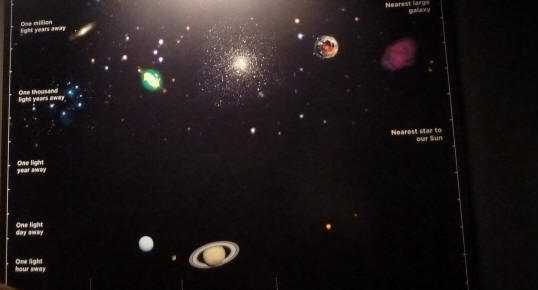
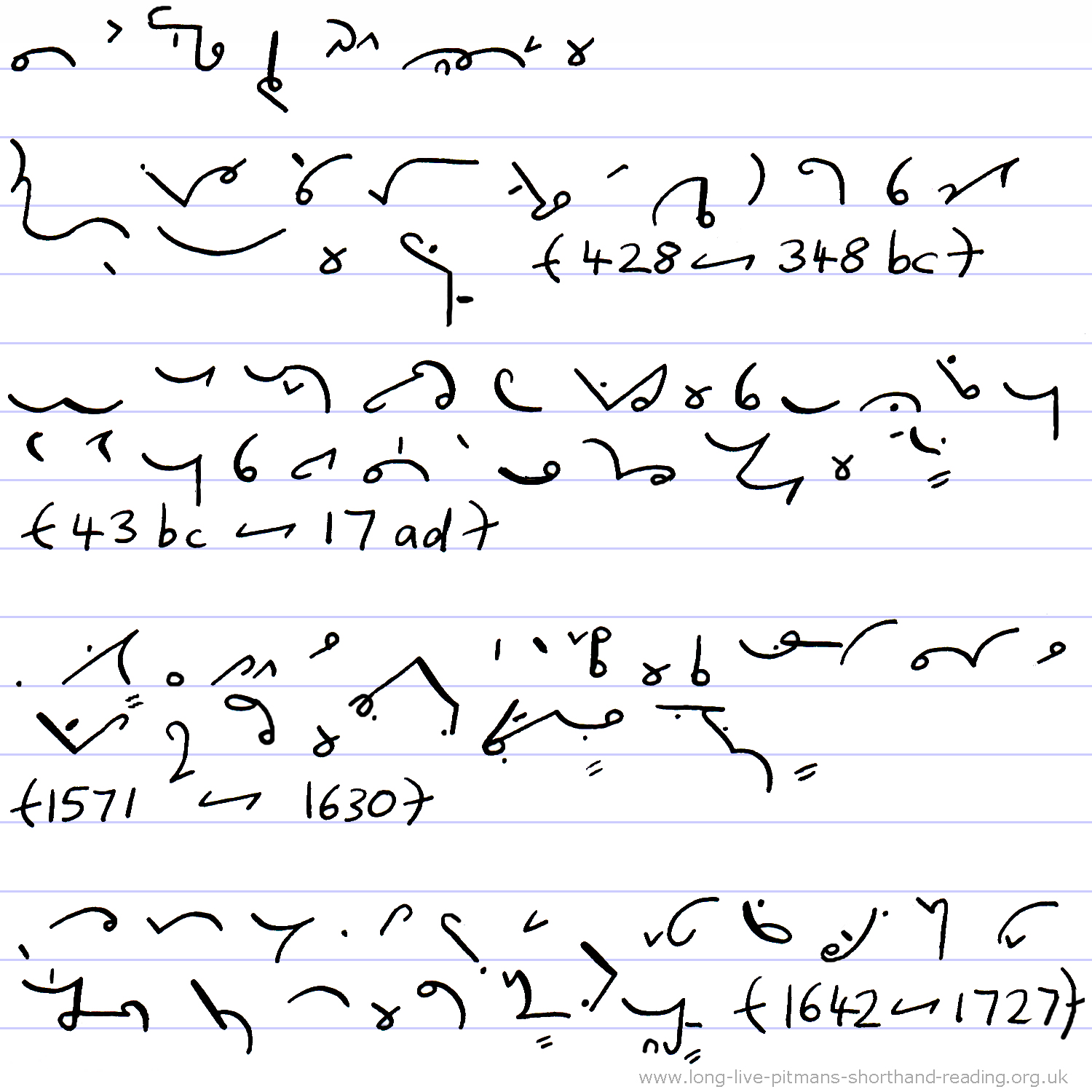
14. Some of the quotations
displayed around the museum:
"Astronomy compels the soul to look upwards and leads
us from this world to another." Plato (428-348 BC)
"Nothing in the entire universe ever perishes . . .
this thing may pass into that, and that into this, yet the sum of
things remains unchanged." Ovid (43BC – 17AD)
"The Earth is round and is inhabited on all sides: it
is insignificantly small and is borne*
through the stars." Johannes*
Kepler (1571-1630)
"To myself I am only a child playing on the beach
. . .
while vast oceans of truth lie undiscovered before me." Sir Isaac
Newton (1642-1727)
* "borne" Note the vowel. Born uses first place thin dash, bourne
(=stream) uses third place thick dash
* "Johannes" For the German pronunciation, use stroke Yay
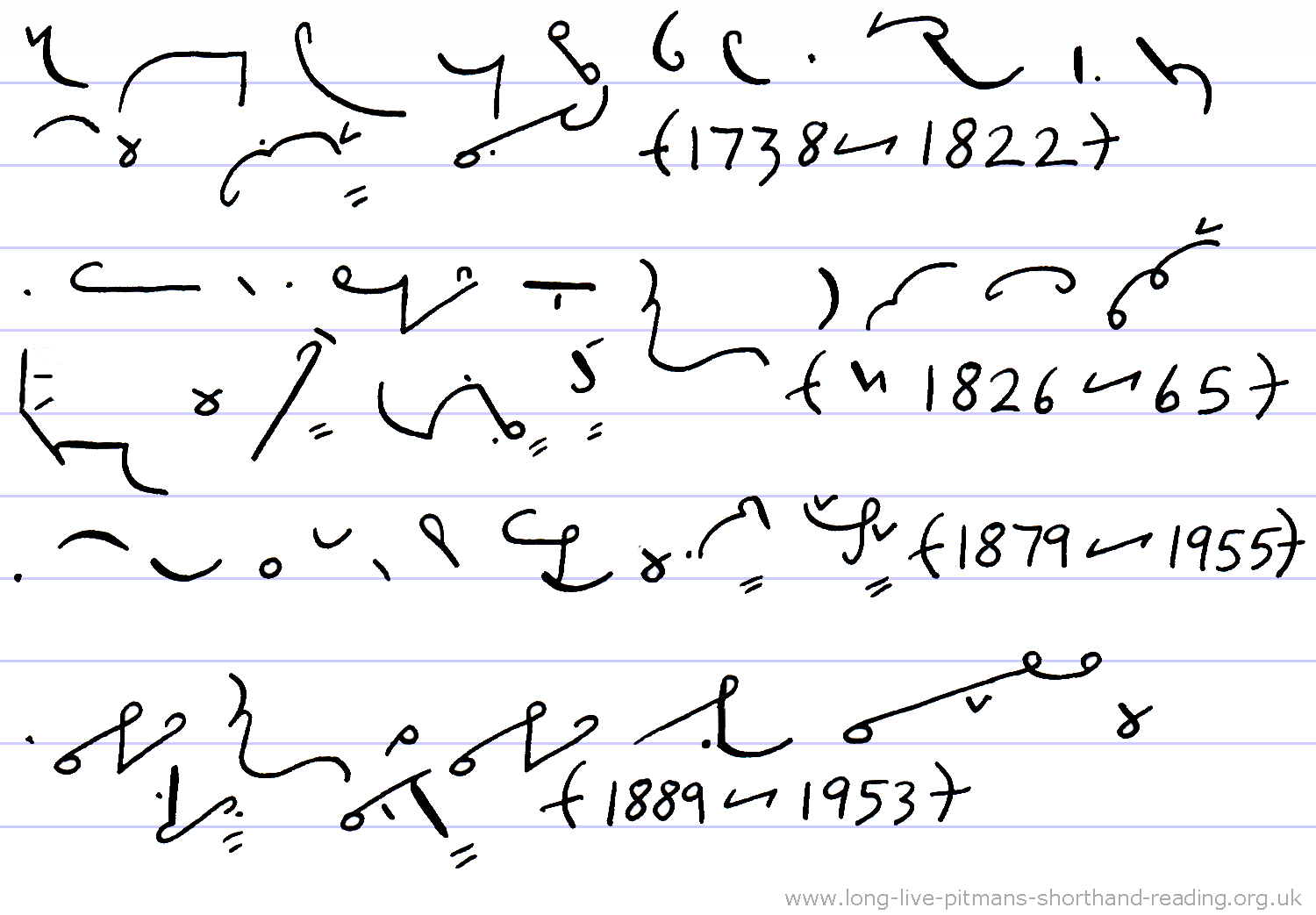
15.
"I have looked further into space than ever a human
being*
did before me." William Herschel (1738-1822)
"A quarter*
of a century ago astronomy was little more than celestial*
topography." George Phillips Bond (about 1826-1865)
"The important thing is not to stop questioning."
Albert Einstein (1879-1955)
"The history of astronomy is the history of receding
horizons." Edwin Hubble (1889-1953)
* "human being" The outline for "human" is written above the line to
distinguish from "humane", and "being" uses the short form "be", so
no diphone required for the "-ing"
* "quarter" Optional contraction
* "celestial" Omits the T
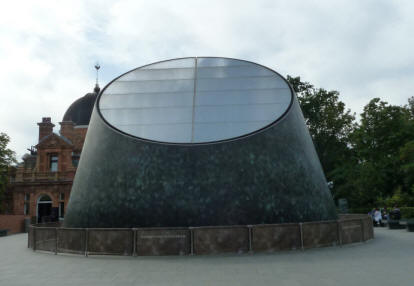
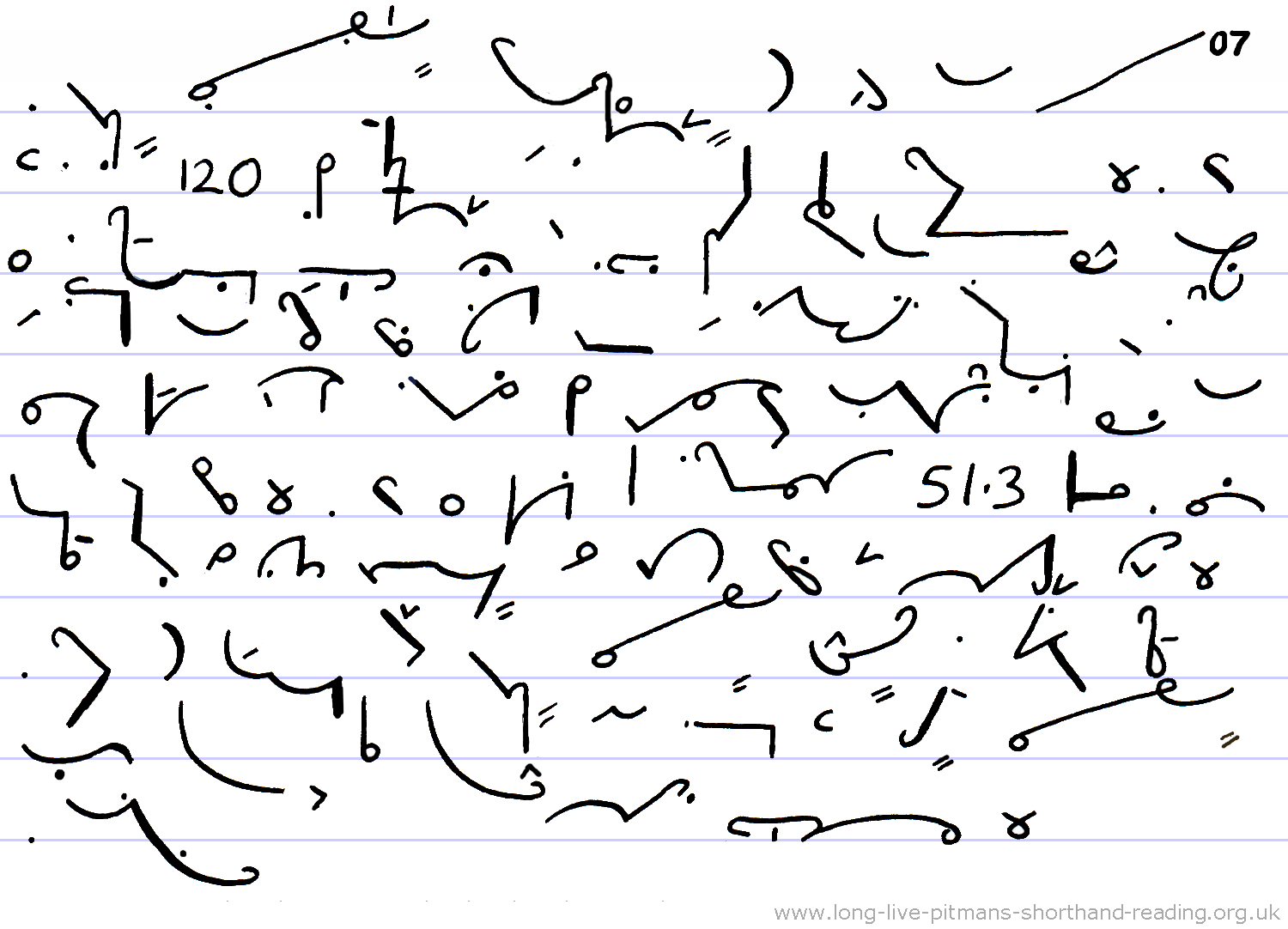
16. The Peter Harrison Planetarium was
opened in 2007*
with a 120-seat*
auditorium and a digital display projector. The building is a truncated
cone, made of concrete for sound insulation and clad in bronze plates
welded together and artificially patinated to a smooth dull mottled
appearance, said to resemble the nebulae*
seen in photos of deep space. The building is tilted at approximately
51.3 degrees, the same as the latitude of Greenwich, and is also placed
on the meridian line. The project was funded by the Peter Harrison
Foundation, a charitable trust named after its founder, and not
connected with John Harrison the inventor of the marine chronometers.
* "2007" Long slash to
represent the current century, arbitrary sign with no phonetic value
* "120-seat" Ensure the circle is on the correct side; written
clockwise it would be "120-seater"
* "nebulae" Latin plural of "nebula", essential to insert the final
vowel in both singular and plural
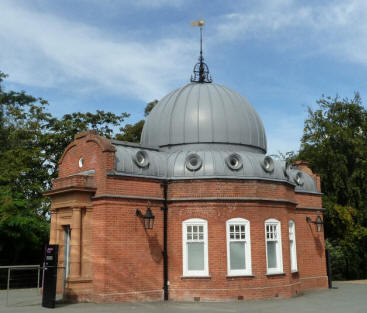
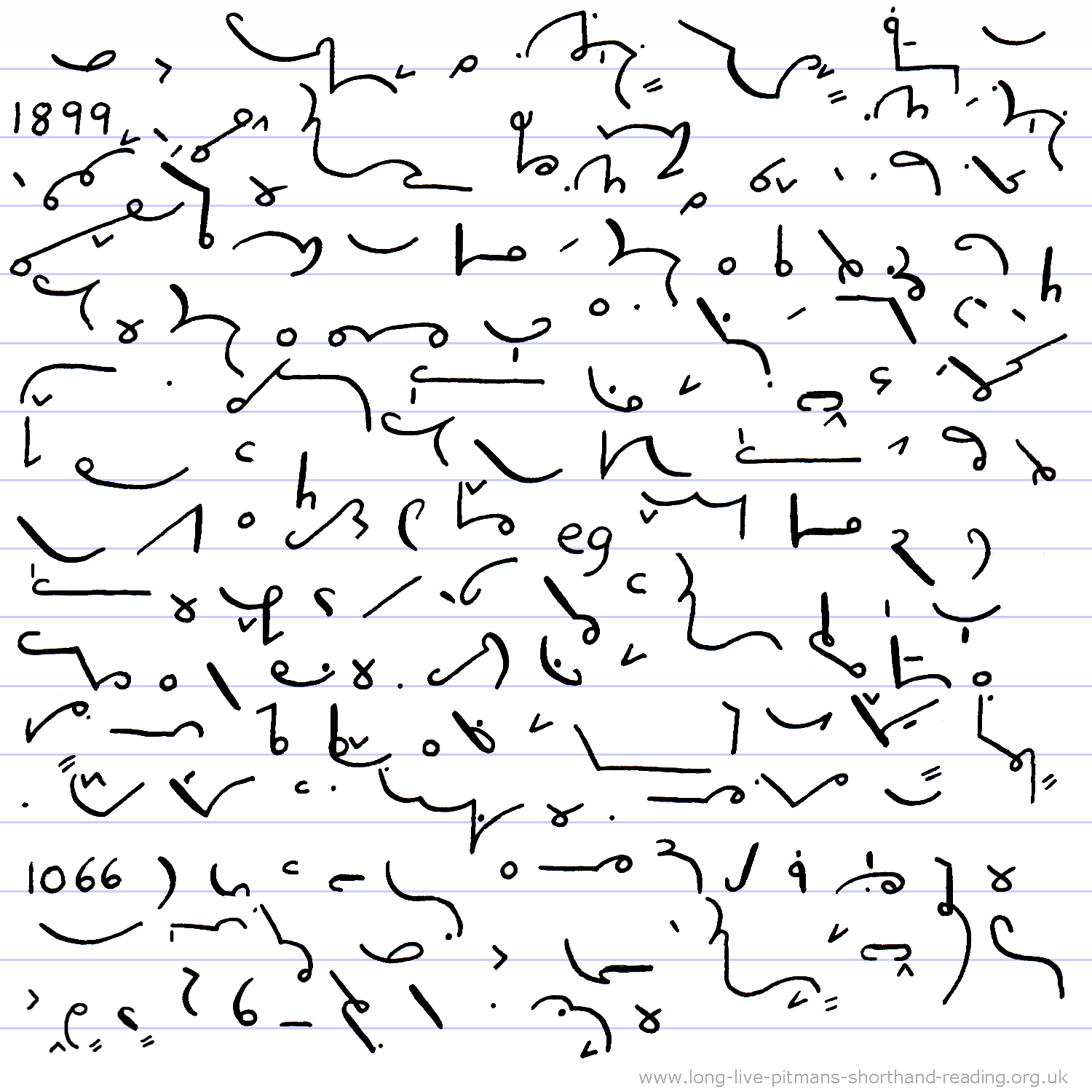
17. Next to the planetarium is the
Altazimuth Pavilion, constructed in 1899 to house astronomical
instruments to measure the altitude*
and azimuth of celestial*
bodies. Altitude is the height of a star above the horizon measured
in degrees and azimuth is its position eastwards from due north.
Azimuth is sometimes known as a bearing and can be thought of like a
circular clock face on the ground with the observer at the centre,
with due north being 12 o'clock and the star's position being read
as one of the other times e.g. 90 degrees would be 3 o'clock. Inside
the building are wall boards with astronomy displays but no
equipment is to be seen. The weather vane on the dome is Halley's
Comet and its design is based on the picture of it in the Bayeux*
Tapestry, a fiery ball with a fantail. The comet's appearance in
1066 was viewed with great fear, as comets were generally considered
omens of disaster. Another comet appears next to the figure
of Astronomia on the ground floor of the South Building, although this could possibly be a
meteor.
* "celestial" Omits the T
* "altitude" Insert the first
vowel in this and "latitude" to distinguish
* "bayeux" A thick dash written sideways to the stroke represents
this French vowel, similar to the English "sir"
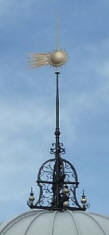
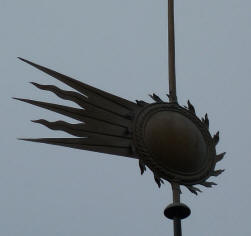

Closeup
picture of the embroidered comet
http://en.wikipedia.org/wiki/Bayeux_Tapestry
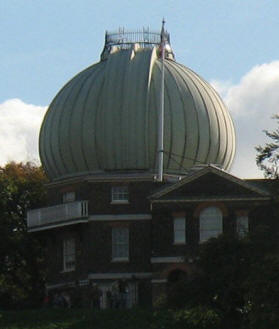
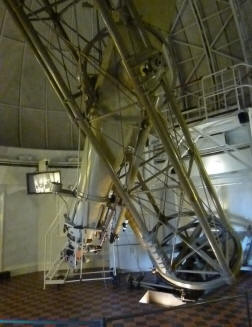
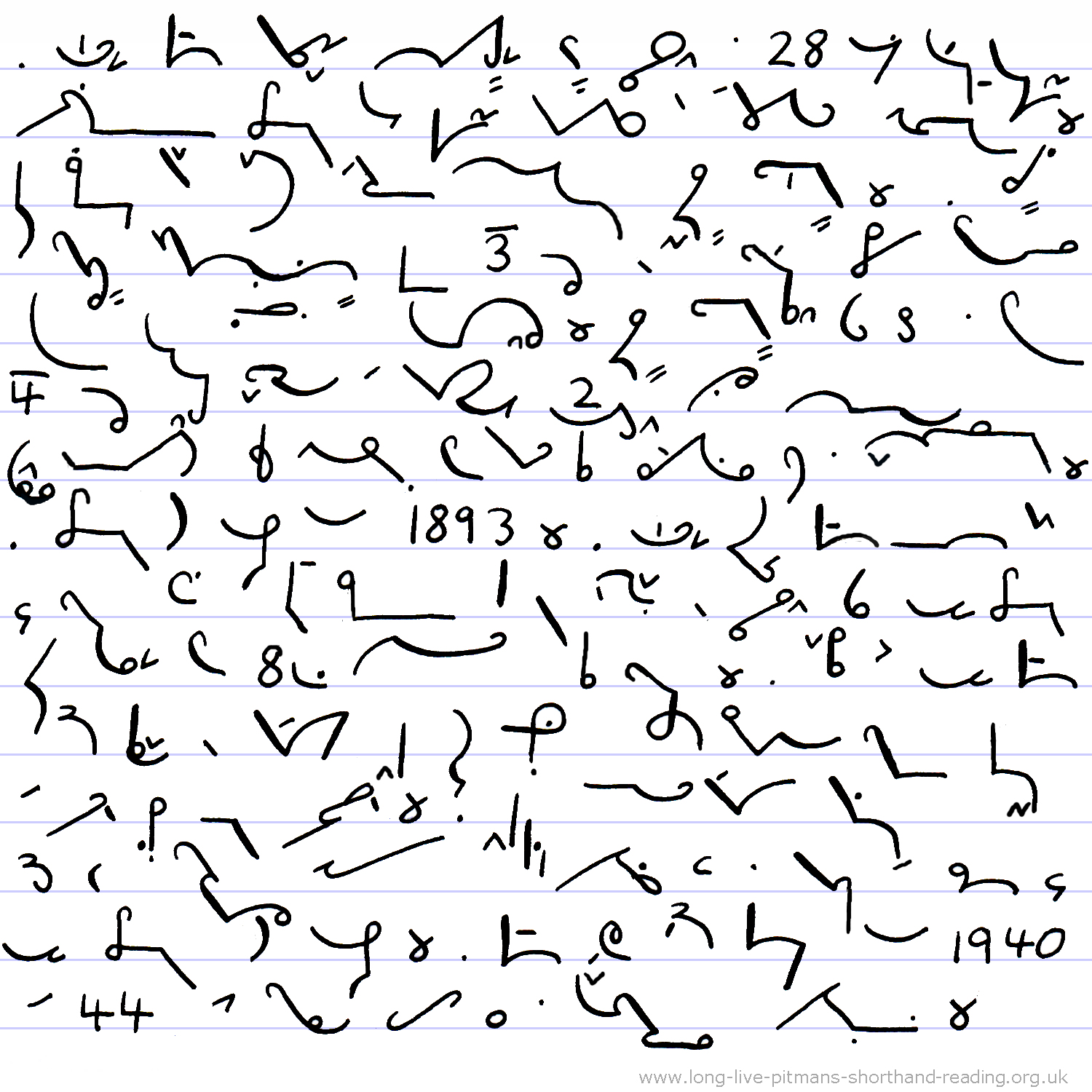
18. The Onion Dome behind the Meridian
Building houses a 28-inch photo-visual refractor*
telescope, for the dual purposes of observation and photography. It was
constructed by Irish optical manufacturer Howard Grubb. The Chance
Brothers of Birmingham*
took 3½*
years to produce satisfactory blanks, after 15 casting failures. Howard
Grubb then spent a further 4½*
years grinding and polishing the 200-pound lens, making thousands of
accuracy tests and inspecting every part of its surface through a
microscope. The telescope was installed in 1893. The onion shape of the
dome came about when the previous flat-topped structure had to be
modified to house this new telescope, which was over 8 feet longer than
its predecessor*.
The sides of the new dome were designed to bulge out so that the
existing supporting brick tower and roof seating could be re-used. The
outdated cannonball bearings were not without problems and were replaced
with a better system when the new telescope was installed. The dome
suffered war damage in 1940 and 1944*,
and the present one is a fibre-glass replica. (2333 words)
* "refractor" Keep the R hook small and insert the vowel after the
Fl stroke, so it does not look like "reflector"
* "Birmingham" The H is not pronounced. There is also a contracted
version which omits the Ing stroke.
* "3½
4½"
Write the numeral first and the dash second, the same order as they
are spoken.
* "predecessor" Three downstrokes are tolerated, in order to provide
a distinguishing outline from the similar "producer" which ends with
Ray
* "1944"
Leave out the century number when there are several dates in close
succession
Top of page
|
